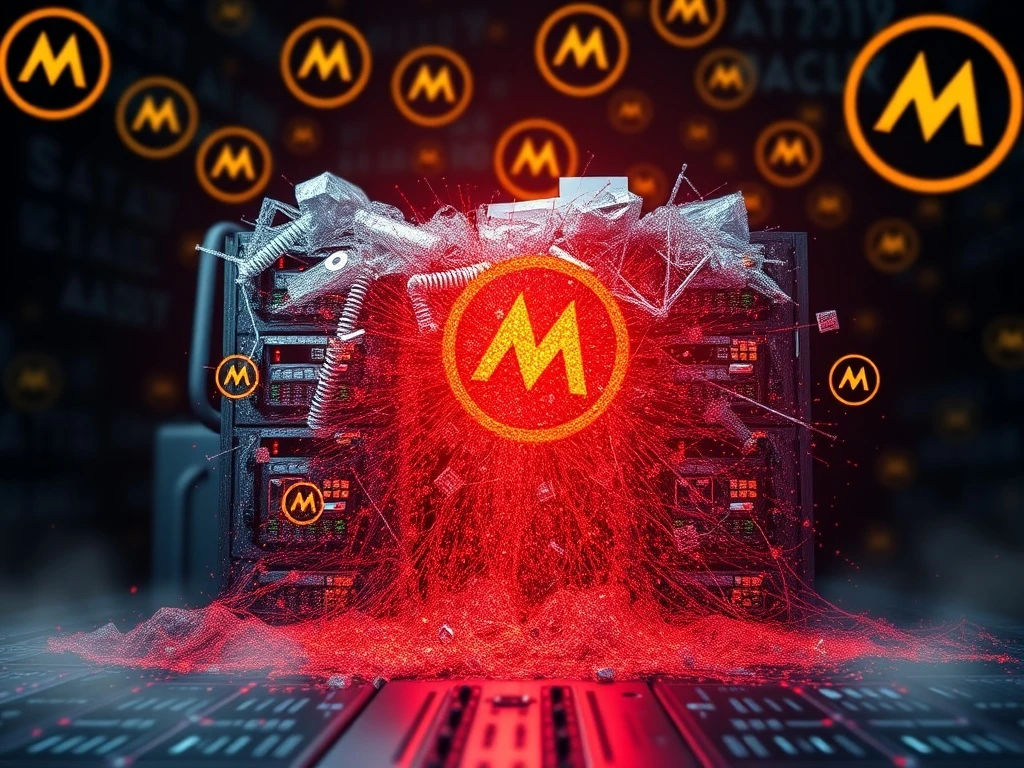Monero 51% Attack: Alarming Disruption Causes Price Dip

The privacy-focused cryptocurrency Monero (XMR) faces an alarming challenge. Recent reports indicate a potential Monero 51% attack, allegedly orchestrated by the Qubic network. This significant event has already caused a notable Monero price dip and raised serious concerns about network stability.
Monero Network Disrupted by Alleged 51% Attack
Monero’s blockchain has experienced considerable disruption. In the past 24 hours, 60 mined blocks were discarded from its main chain. The Monero Consensus Status dashboard clearly shows these 60 orphaned blocks within 720 recent blocks. This disruption coincides with an ongoing economic attack by the Qubic network. Qubic incentivizes what is known as selfish mining. Qubic miners redirect their computing power to mine Monero (XMR). They then sell the proceeds to buy and burn Qubic tokens. In return, they receive payment in QUBIC. Reports suggest Qubic miners earn more under this specific setup compared to traditional Monero miners. This strategy directly fuels fears of a possible Monero 51% attack. Such an attack is a rare yet serious event. It could allow attackers to rewrite transactions or even block them entirely.
Understanding Orphaned Blocks and Selfish Mining’s Impact on Monero Price
To clarify, an orphaned block is a valid block. However, the network excludes it from the main chain. This occurs because another competing block at the same height was accepted first. In the context of selfish mining, a miner possessing significant hashrate intentionally withholds blocks. They then publish these blocks strategically. This tactic aims to overtake the public chain. Consequently, honest miners’ work becomes discarded. This process directly impacts blockchain security. At the time of writing, Monero’s price stands at over $247. This figure represents a decline of over 8.6% from its 24-hour high of over $276.

Qubic’s Claims and Expert Skepticism on Monero’s Vulnerability
The Qubic network openly engages in selfish mining through its Monero mining pool. Qubic founder Sergey Ivancheglo admitted this activity in an X post. Ivancheglo claimed on Tuesday that “Qubic has achieved 51% over Monero.” His team awaits independent confirmations. A Monero 51% attack happens when a single entity controls over half of a blockchain network’s mining power. This control permits manipulation of transactions. Zhong Chenming, co-founder of SlowMist, a crypto cybersecurity firm, stated on X that the 51% attack on Monero “seems to have succeeded.” He acknowledged the high cost involved. Chenming also questioned the ultimate economic benefits. Theoretically, the Qubic mining pool could now rewrite the blockchain. They could achieve double-spending or censor any transactions.

However, not everyone is convinced. Doubts persist regarding the successful execution of a full 51% attack. Engaging in selfish mining with high hashrate, yet short of a majority, can still cause orphaned blocks occasionally. CoinWarz estimates Monero’s total hashrate at 5 GH/s. Unverified data from Qubic claims a peak hashrate of 3.01 GH/s. This amount would be sufficient. Their current reported hashrate is 2.08 GH/s, which is insufficient for a 51% attack. The Monero Consensus Status further indicates that unknown mining pools and solo miners, including Qubic, reached nearly 30% of the blocks mined on August 11. This might suggest Qubic controlled most hashrate briefly. Alternatively, they controlled a significant minority. Luke Parker, lead developer at SeraiDEX, disputed reports of a successful 51% attack. He noted that a six-block-deep network reorganization with block orphaning does not confirm a “51% attack.” Parker added, “It does mean an adversary with a high amount of hash got lucky.” These varying perspectives highlight the complexity of assessing blockchain security during such events.
The Escalating Hack War and Broader Implications for Blockchain Security
Qubic and Monero are engaged in an escalating “hack war.” Both networks trade countermeasures. Ivancheglo previously noted on X that Monero broke Qubic’s selfish mining system. This prompted his subsequent fix. Before this, Ivancheglo accused Sergei Chernykh, a developer of Monero mining software XMRig, of conducting a denial-of-service (DDoS) attack on Qubic’s pool. This allegedly led to hashrate losses. Chernykh disputes this claim. The initial attack began in late July. The community then noticed what they described as an “economic attack.” This operation uses economic incentives. It pays Qubic miners more than Monero miners. The goal is to gain control over most of Monero’s hashrate. Consequently, this would give them control over the network.
Niko Demchuk, head of legal at AMLBot, an onchain forensics firm, weighed in. He told Crypto News Insights that Qubic’s attack on Monero could be considered “computer sabotage” or “unauthorized access.” This interpretation falls under Belarusian and European Union laws. However, no specific statute explicitly mentions 51% attacks. Demchuk indicated Belarus’ cybercrime rules could apply. This would be true if blockchain manipulation disrupts protected systems. The ongoing situation emphasizes the critical need for robust blockchain security measures. It also highlights the challenges in defining and prosecuting decentralized network attacks. The future of Monero price stability and its network integrity hinges on the resolution of this unprecedented conflict.







